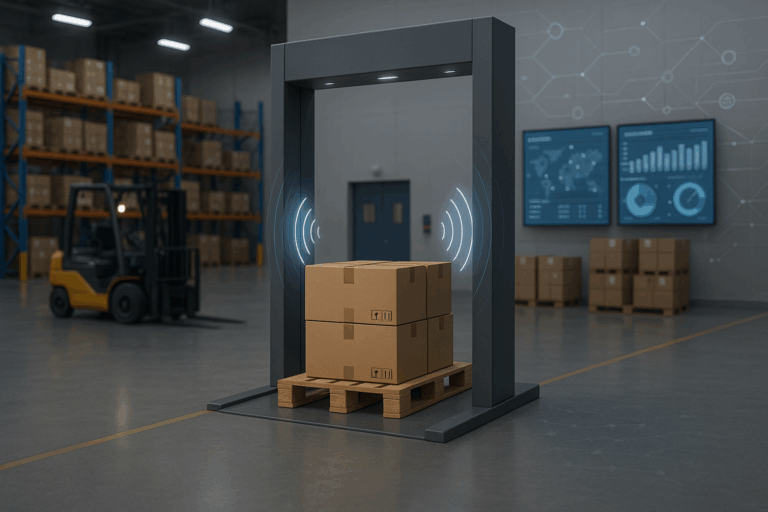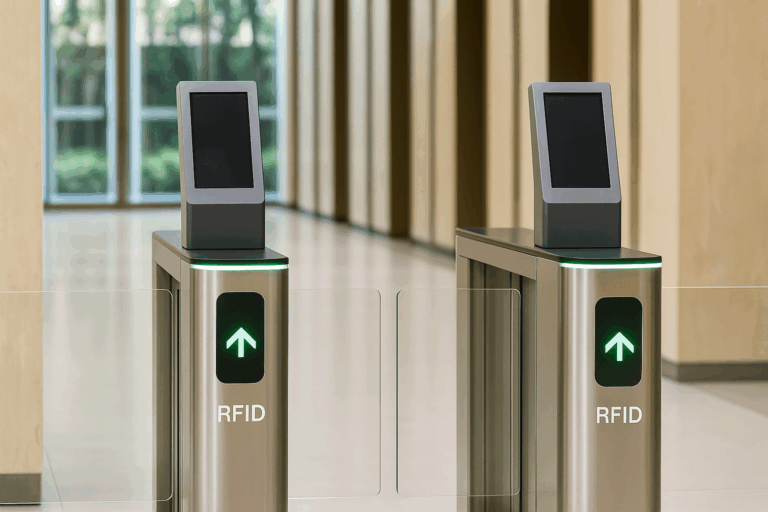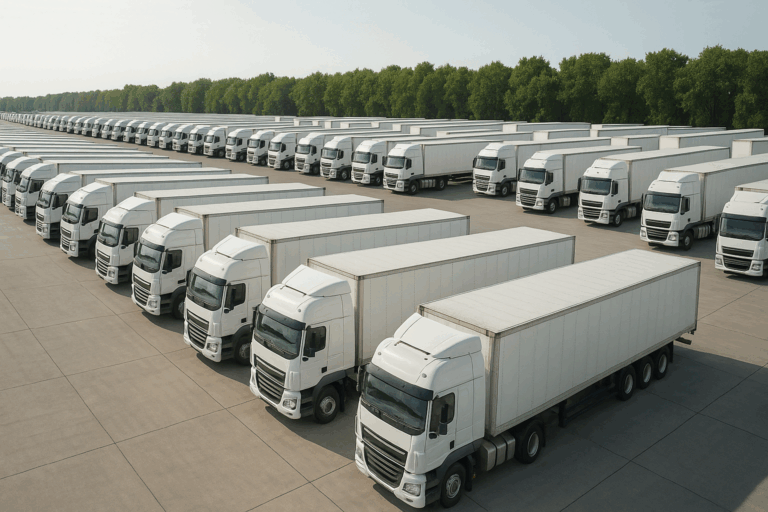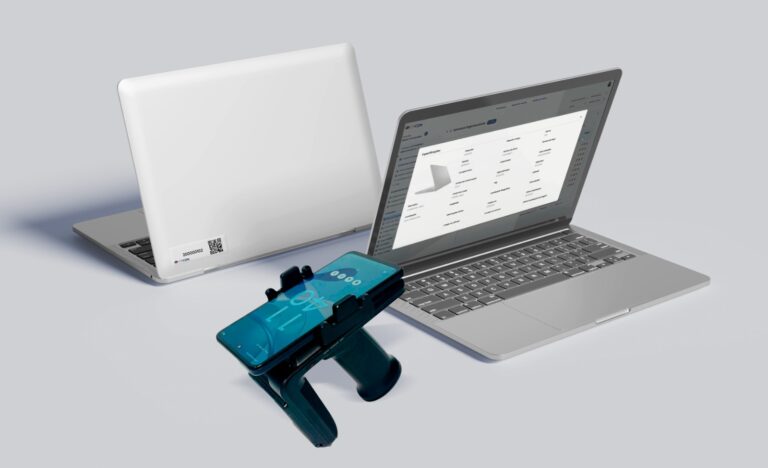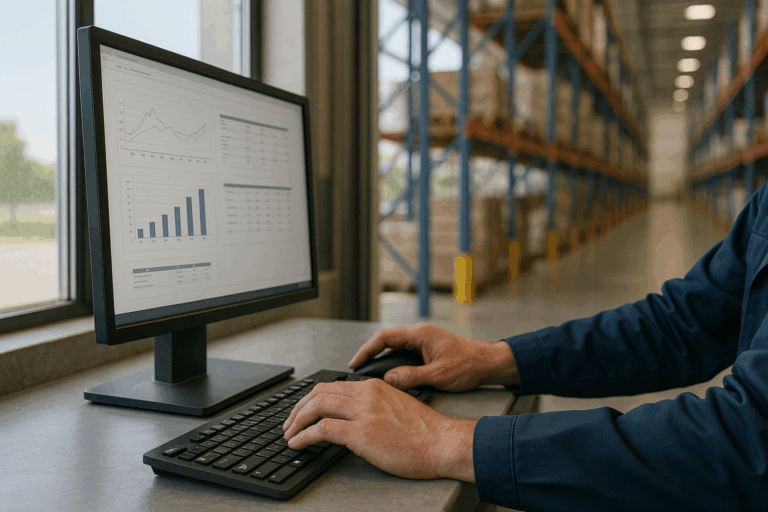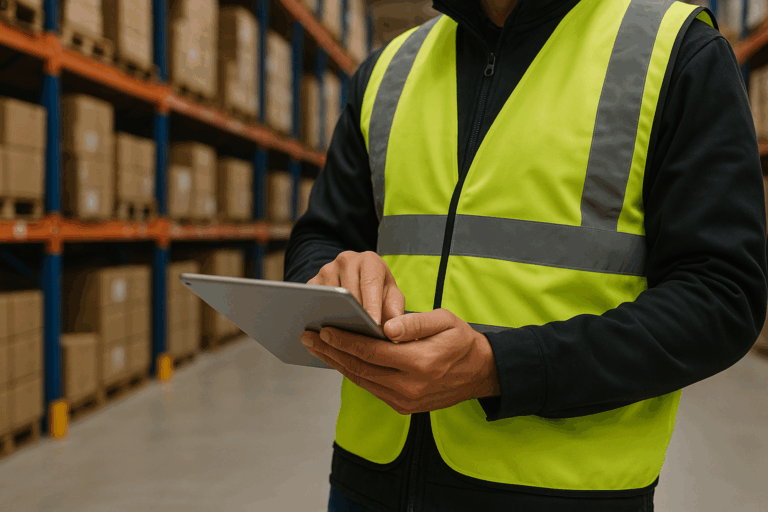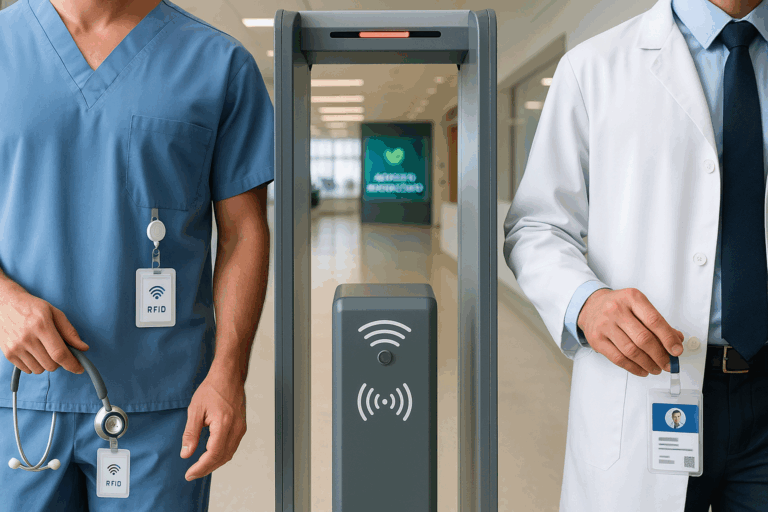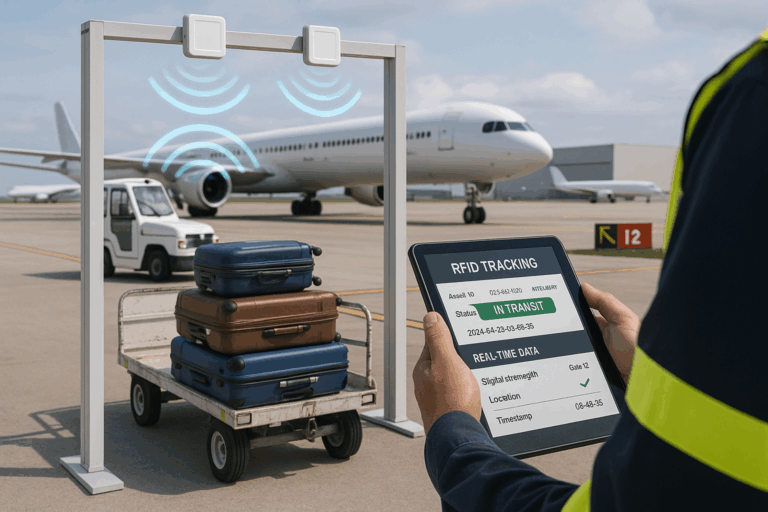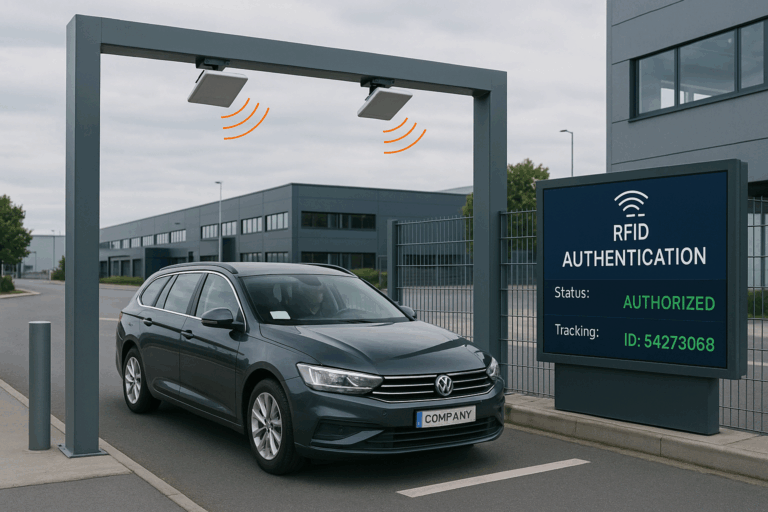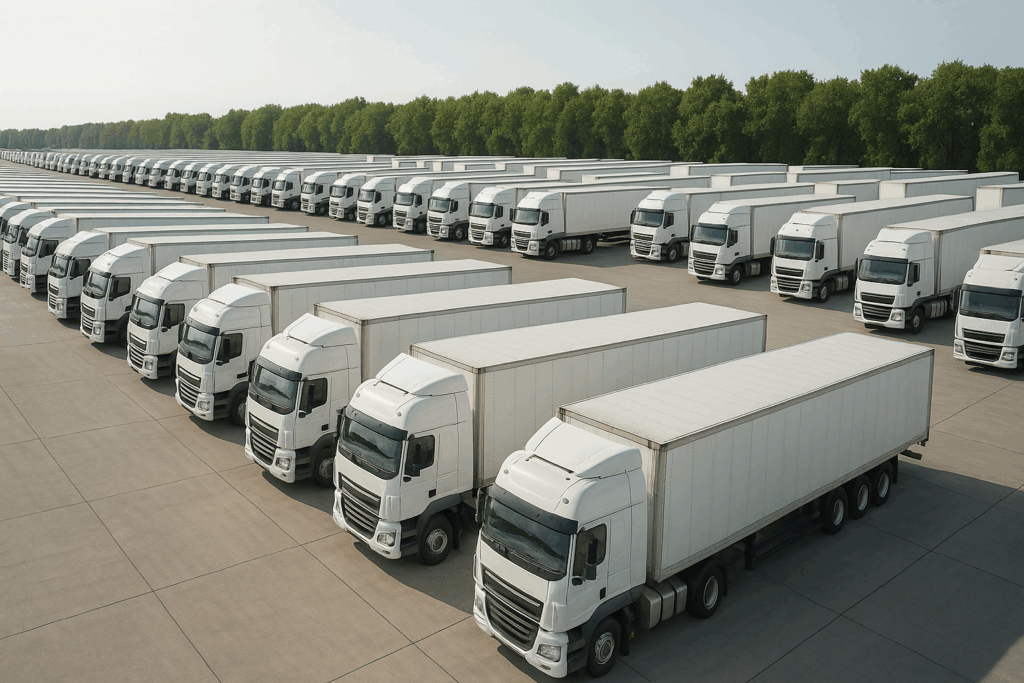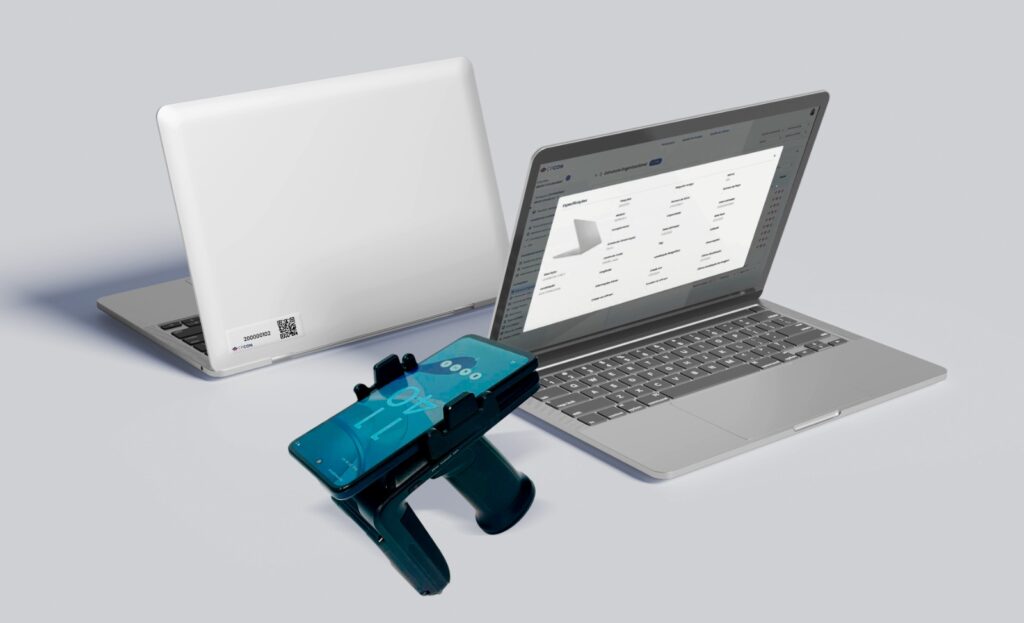In today’s fast-moving supply chains, precision and speed are no longer optional — they’re essential. Yet many logistics operations still rely on manual processes, barcode scanners, or outdated systems that create bottlenecks, inventory discrepancies, and limited visibility across the flow of goods.
That’s where the RFID portal for logistics makes all the difference.
An RFID portal is a smart, automated gateway that instantly reads RFID tags on assets, pallets, equipment or shipments — as they pass through key checkpoints like warehouse doors or loading docks. No manual scanning. No physical contact. Just real-time data, captured in seconds, with 100% traceability.
This technology solves one of the biggest pain points in logistics: the lack of full visibility over asset movement. With RFID portals, companies gain immediate control over inbound and outbound flows, reduce human error, and accelerate every stage of the operation — from receiving and inventory to dispatch and audits.
In this article, you’ll learn exactly how RFID portals work, where they’re used, and why they’re becoming a game-changer for logistics teams aiming to operate faster, smarter and with total control.
Let’s dive in.
Table of Contents
ToggleWhat Is an RFID Portal and How Does It Work in Logistics?
An RFID portal is a fixed structure equipped with antennas and RFID readers, designed to automatically identify items as they pass through. Think of it as a smart gate that reads dozens — or even hundreds — of RFID tags at once, without needing human intervention or line-of-sight scanning.
In a logistics environment, these portals are strategically installed at high-traffic points like warehouse entrances, receiving docks, or dispatch zones. As assets move through the portal, the system captures their RFID signals and instantly sends the data to a central platform — updating inventory levels, confirming shipments, or triggering alerts in real time.
The entire process takes just seconds, and it works even if items are moving, stacked, or not visible to the reader. Unlike traditional barcodes, which require one-by-one scanning, RFID portals offer fast, contactless, and batch-level identification.
Here’s how the RFID portal works step by step:
- RFID tags are attached to items like boxes, pallets, or equipment.
- Antennas emit radio frequency signals that power the tags as they pass by.
- RFID readers capture the tag data and send it to a software system.
- The system logs the exact time, direction, and identity of each movement.
This level of automation eliminates manual errors, speeds up operations, and provides complete traceability of goods across every stage of the supply chain.
For companies that deal with large volumes of materials — whether in logistics hubs, distribution centers, or production facilities — an RFID portal is not just a convenience. It’s a critical enabler of operational efficiency, compliance, and growth.
Real-Time Data, Full Traceability: Main Benefits of RFID Portals
In logistics, visibility is everything. Knowing exactly where your inventory is, when it moved, and in what condition can be the difference between an efficient operation and costly delays. That’s where RFID portals offer a significant advantage.
By automating the identification and tracking of goods, RFID portals remove the guesswork from daily logistics. Instead of relying on manual records or scanner-based systems that require human input, these portals capture every movement as it happens.
The first major benefit is speed. A single RFID portal can read hundreds of tags at once, even if items are in motion or stacked together. This reduces the time spent on loading, unloading, and verifying shipments.
Another key benefit is accuracy. Since the system logs entries and exits automatically, there is no risk of forgetting to scan an item or recording it under the wrong code. This means fewer inventory discrepancies and faster cycle counts.
RFID portals also improve traceability. You can track every tagged item from the moment it enters the facility to the moment it leaves. This is especially important in industries like healthcare, manufacturing, and food logistics, where compliance and product integrity are critical.
Additionally, real-time data enables faster decision-making. Managers can spot delays, shortages, or anomalies as they occur and act immediately. This level of insight helps prevent losses and ensures that service levels remain high.
There’s also a financial upside. Reducing shrinkage, avoiding stockouts, and streamlining labor all contribute to lower operational costs. Over time, these savings more than justify the investment in RFID infrastructure.
In short, RFID portals bring visibility, control, and confidence to logistics operations that need to run faster, smarter, and with less risk.
How Different RFID Portal Models Fit Different Logistics Needs
Not all logistics operations are the same. Some move high volumes of pallets through loading docks. Others track small, high-value items across labs or data centers. That’s why RFID portals come in different shapes and configurations, each built to meet a specific operational need.
The most common model is the fixed portal. This version is typically installed at dock doors or warehouse entry points. It forms a visible frame around the passage area, with antennas mounted on each side. These portals are ideal for high-traffic areas and are capable of reading many tags in a short time.
For tighter spaces or more discreet installations, companies often use wall-mounted read points. These setups place antennas on walls or ceilings without a full structural frame. They work well in offices, IT asset rooms, and smaller inventory areas where space is limited and movement is lighter.
Floor-embedded antennas are another option, especially in operations with forklift traffic or low ceiling height. These antennas are installed directly in the ground and read tags as items pass overhead. They’re useful in heavy industrial settings or when you can’t block pathways with equipment.
Ceiling-mounted portals are common in production lines or inspection areas. They read tags from above, scanning items as they pass beneath. This model is great when the lateral area needs to stay clear for workers, carts, or machinery.
The key to selecting the right RFID portal is understanding your flow of materials, the layout of your facility, and the environment around the read points. Factors like metal interference, signal range, and tag orientation all play a role in system performance.
What makes RFID portals so effective is that no matter the model, they can all be integrated with inventory systems or warehouse management software. This creates a seamless connection between physical movement and digital records, improving operational accuracy from end to end.
Is It Worth the Investment? ROI and Cost Considerations
When it comes to upgrading logistics systems, cost is always a factor. But with RFID portals, the question isn’t just about how much you spend — it’s about how much you save.
A typical RFID portal setup includes the physical frame, antennas, readers, cabling, and integration with your software. Depending on the complexity of your operation, prices can start around $5,000 to $10,000 for basic setups, and reach over $50,000 for larger, high-traffic facilities with multiple read points and advanced features.
At first glance, this might seem like a big investment. But let’s look at what you gain in return.
First, there’s time. RFID portals cut hours off manual processes. What used to take a full shift — like cycle counting or checking outbound shipments — can now happen automatically, in minutes.
Second, accuracy. Errors in inventory records, missed scans, and mislabeling create downstream problems that cost real money. RFID dramatically reduces those risks.
Then there’s visibility. With real-time data on every item’s movement, you make better decisions faster — and avoid costly disruptions or delays.
Many companies also use RFID to tighten security. By automatically logging what enters and exits, shrinkage and theft are easier to detect and prevent.
Finally, the long-term value is in scalability. Once the system is in place, it’s easy to expand to other locations or layers of your supply chain, multiplying the return on your initial investment.
Bottom line: an RFID portal is not just a tech upgrade. It’s a strategic move that delivers long-term savings, better performance, and peace of mind across your logistics operation.
Learn more
- RFID Portal for Airports: Intelligence and operational control for your management
- RFID & F1: Accelerating innovation with smart tracking
- RFID portal for vehicle authentication: Traceability and control for your operation
CPCON: A Strategic Partner for RFID Implementation in Logistics
Implementing RFID in a logistics environment takes more than just buying equipment. You need the right design, the right technology, and a partner who understands the complexity of your operation.
That’s where CPCON stands out.
With 29 years of experience in asset management and supply chain optimization, CPCON delivers end-to-end RFID solutions tailored to your logistics reality. We handle everything — from technical planning and hardware installation to software integration and post-implementation support.
Every portal is built based on your actual flow of materials, space constraints, and system architecture. We don’t sell one-size-fits-all setups. We deliver custom-built RFID infrastructure that works from day one.
Our team combines technology, data intelligence, and hands-on field experience to help your operation evolve with full control. Whether you’re running a single distribution center or managing a nationwide logistics network, CPCON ensures your RFID investment delivers maximum value.
We’ve helped major companies improve inventory accuracy, reduce shipping errors, speed up dispatches, and gain complete visibility over their supply chain. And we can do the same for you.
If you’re looking to bring automation, traceability, and speed to your logistics, CPCON is the partner to make it happen — with precision, reliability, and scale.
RFID Portal Is the Future of Logistics
Adopting an RFID portal is more than a technology upgrade — it’s a step toward smarter, faster, and more secure logistics. With automated tracking, real-time data, and full visibility across your supply chain, your operation becomes more efficient, more reliable, and ready to scale.
If your company is looking to improve inventory accuracy, reduce losses, and accelerate logistics performance, now is the time to act.
Talk to the experts at CPCON and discover how a customized RFID portal can transform your logistics operations.
Contact our team and request a tailored solution.
FAQ
What is an RFID portal and how is it used in logistics?
An RFID portal is a fixed reading point equipped with antennas and RFID readers. In logistics, it’s installed at key locations like warehouse doors to automatically track the movement of pallets, boxes, or equipment without manual scanning.
How does an RFID portal improve logistics tracking?
It provides real-time visibility into the location and movement of goods. Every tagged item is detected as it passes through, giving logistics teams accurate data for inbound, outbound, and internal transfers.
Can an RFID portal replace manual inventory counts?
Yes. RFID portals enable automated inventory updates as items move, eliminating the need for manual counts and reducing errors caused by miscounts or forgotten scans.
What types of companies benefit most from RFID in logistics?
Distribution centers, manufacturing plants, e-commerce warehouses, healthcare providers, and transportation hubs all benefit. Any business with high asset turnover or tight delivery schedules gains speed and control from RFID.
Is it possible to integrate RFID portals with ERP or WMS systems?
Absolutely. CPCON’s RFID solutions are designed to integrate with your existing ERP or WMS, ensuring seamless data flow, faster processing, and a complete digital view of your logistics operations.
The article presents the RFID portal as a key solution for transforming logistics operations through automation, real-time data, and full traceability. It explains how the technology works and explores its strategic applications in inventory control, shipping, asset tracking, and secure access management.
RFID portals are shown to be adaptable to different logistics environments, from large distribution centers to high-security facilities, offering faster processes, higher accuracy, and reduced losses. The article also emphasizes the strong return on investment, as companies gain operational visibility, cut manual labor, and improve decision-making with reliable data.
Positioned as a global leader in asset management and logistics automation, CPCON offers end-to-end RFID solutions. With 25+ years of experience, the company delivers customized implementations that integrate technology, software, and strategic consulting to help clients scale operations, reduce risk, and prepare for the future of logistics.
Get to Know CPCON Group: A global expert in asset management and inventory solutions
CPCON Group is a global leader in asset management, fixed asset control, and RFID technology. With over 25 years of experience, we have supported major companies such as Nestlé, Pfizer, Scania, BASF, Coca-Cola Andina, Vale, Vivo, Petrobras, and Caixa in high-complexity projects.
Curious about our global footprint? We are present in:
- North America: Toronto, New York, Miami, Minneapolis, Seattle, Dallas
- Latin America: São Paulo, Buenos Aires, Lima, Bogotá, Mexico City
- Europe: Lisbon, Porto, London, Birmingham, Milan, Rome, Turin, Madrid, Bilbao
- Middle East: Dubai, Saudi Arabi
- Caribbean: Tortola, Grand Cayman
Follow our LinkedIn Showcase Page and stay updated with strategic content on asset control, inventory management, and RFID innovation across industries.

